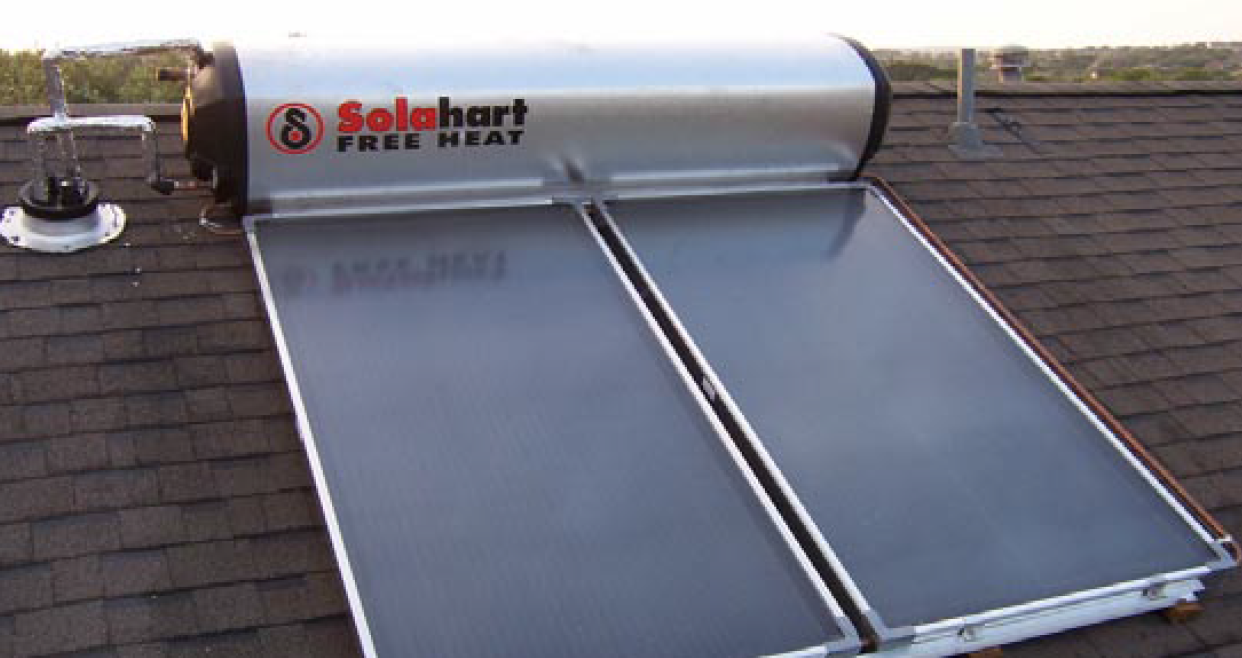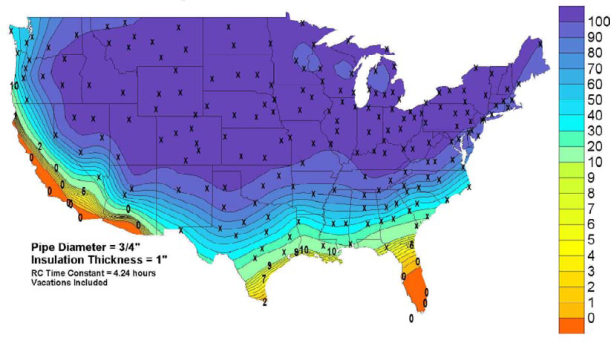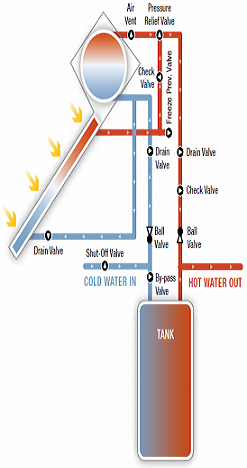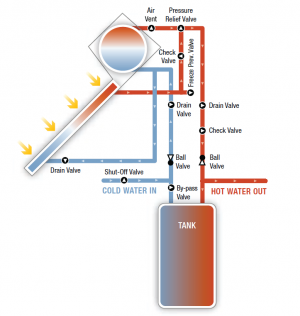Scope
Install a thermosiphon solar hot water system.
- First determine that the roof and utility room space are suitable for solar hot water components.
- Follow the requirements for all local codes.
- Choose an accredited solar water heating installation company.
- Size the system according to the home’s hot water demands.
- Mount the system on an unshaded, southern exposure if possible.
- Ensure that the roof mounting system avoids water intrusion and damage to the roof structure.
- Install a thermosiphon if you are choosing a low-maintenance solar hot water system that does not require a mechanical pump.
See the Compliance Tab for links to related codes and standards and voluntary federal energy-efficiency program requirements.
Description
Thermosiphon systems are passive with a storage tank located higher than the solar collector. They rely on passive natural convection where more dense cold water falls, moving hotter water to the storage reservoir at the top. Some systems come prepackaged with tanks pre-mounted to collectors. In these systems the tank sits on the outside of the roof. Other systems have tanks located inside attic spaces above the collectors. In the case of a direct system, potable water is used as the heat transfer fluid.
Passive direct themosiphon systems are usually limited for use in coastal areas of Texas, southern California and Central Florida. (See the Climate section for more information.)

Passive indirect thermosiphon systems are also available which utilize polypropylene glycol with a heat exchanger to avoid freezing. In warm climates, care must be taken to avoid stagnant conditions that can lead to the glycol overheating. In climates that freeze, the water pipes and tanks containing water must be in a conditioned space.
Installation of a thermosiphon solar hot water system on a roof requires proper connection to the roof substrate. The manufacturer-designed attachment kit provides long-term and secure attachment to the collector. It is inappropriate to use other building materials such as wood blocks to mount an integrated collector system.
To ensure that other components of the home are ready for a solar thermal system, use the following guides:
- Utility Room Space
- Mounting Surface for Pumps and Gauges
- Solar Bypass Valve
- Solar Plumbing and Wiring Chase
- Architectural Drawing
Install a Thermosiphon Solar Hot Water System
- Select an approved manufacturer that has been certified and listed by an accredited institution such as the Florida Solar Energy Center – FSEC. Solar systems certified by SRCC (OG-300) may qualify for tax credit or additional rebate incentive programs. The North Carolina based organization Database of State Incentives for Renewable Energy (DSIRE) maintains a data base map for state, local, utility and federal incentives and policies that promote solar renewable energy.
- Size the solar thermal system accordingly to provide at least 50% of the homes’ water heating energy needs. Solar system selection should be certified by the Solar Rating Certification Corporation (SRCC), the International Association of Plumbing and Mechanical Officials (IAPMO), or be labeled with Energy Star.
- A solar thermal collector is preferably mounted on an unshaded southern exposure orientation; however, eastern or western orientations are not to be ruled out. The use of a sun chart or approved analysis tool is recommended to determine seasonal shading.
- Solar water heating system installations should comply with local building and plumbing codes. Installation should be executed by a trained certified installer. The North American Board of Certified Energy Practitioners (NABCEP) provides a national database on their website that lists certified solar contractors. In addition, the Solar Energy Industry Association (SEIA) provides a map listing of products, companies and solar services.
- Collector mounting on a roof substrate requires special attention to avoid water intrusion or damage to the roof structure. Builders and installers should take into consideration mounting and positioning of the collector to comply with wind zones, particularly in coastal areas.
- Plumbing lines to the collector are to be kept at minimal length, preferably at 25 feet, and are usually routed through attics where they are continuous with sleeved insulation. Exterior plumbing lines are also possible with an architectural chase for better appeal.
Success
Installation of a thermosiphon solar hot water system is no more difficult than the assembly of any other building component when proper design precautions are taken into consideration. Builders are encouraged to work with solar installers and manufacturers to select a package for high consumer acceptance. Building aesthetics and minimal use of floor space are a high priority to customers in new homes.
Selection of a solar contractor should be based on credentials, local company service territory, years of experience and trust. Warranty and maintenance agreement of at least two years is recommended.
Climate
The DOE Zero Energy Ready Home PV-Ready Checklist (Revision 07) is required only under the following condition related to climate (See the Compliance Tab for other exceptions):
- Location, based on zip code, has at least 5 kWh/m2/day average daily solar radiation based on annual solar insolation using the PVWatts online tool. See map below.

Water heating energy use varies according to the region and amount of hot water gallons used in a residence.

Table 1. Expected annual energy use and annual cost ($), for a typical household using 60 gallons/day, for selected states.
*Simulations performed in EGUSA (Colorado and New York water heater location in basement, others located in garage)
Overheating and Freezing
Solar thermal water heating system failures may originate from extreme cold and hot temperature conditions. Collector and pipe freezing is a major obstacle solar thermal systems face to avoid operation interruption and to ensure a long-term service life. Increased probability for pipe freezing is higher in mid and northern states, as shown in the figure below.

Figure 3. Probability of at least one pipe freeze in 20 years.
Pipes should be insulated with a minimum of 1 in. insulation (closed cell preferred) and those exposed to ultraviolet (UV) should be protected by using a form a jacketing (UV inhibited acrylonitrile butadiene styrene (ABS), polyvinyl chloride (PVC) or aluminum). Passive systems may require a freeze valve for extra protection in regions above central Florida. Freeze exposed potable water piping may be avoided by using heavier insulation such as R-12.
Training
Compliance
Compliance
Installation of a solar thermal system requires building code compliance. Requisites for code compliance may differ by area, city, or county. Refer to the local governing code ordinance for specific plumbing and electrical rules.
International Energy Conservation Code (IECC)
Retrofit
SCOPE
Installation of a solar thermal system on an existing roof is similar to installation on the roof of a new home. See the Scope, Description, and other tabs for guidance.
Consult a structural engineer and manufacturer guidance to determine if the existing roof can carry the load.
Ensure that all penetrations through the roof are adequately sealed to prevent water leaks. New flashing should properly integrate with existing roof underlayment and cladding layers.
See the U.S. Department of Energy's Standard Work Specifications for more information about solar water heating.
COMPLIANCE
See Compliance tab.
More
More Info.
Access to some references may require purchase from the publisher. While we continually update our database, links may have changed since posting. Please contact our webmaster if you find broken links.
The following authors and organizations contributed to the content in this Guide.
Sales
Solar Hot Water = Solar Hot Water System

Solar water heaters use energy from the sun to naturally heat water. These systems usually include one or two collectors that typically sit on a house’s roof. System designs can vary depending on many factors such as aesthetics, rigor of freezing conditions and cost. Homes ready for solar water heating systems should be designed with adequate space on the roof that is unshaded and with enough space in the utility room for a water storage tank and any needed pumps and controls.
